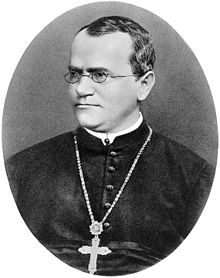Gregor Mendel
Gregor Johann Mendel (Heinzendorf, Austria,[1] 20 July 1822 – Brünn, Austro-Hungary,[2] 6 January 1884) was an Austrian monk and botanist.[3]
Gregor Johann Mendel | |
|---|---|
 | |
| Born | July 20, 1822 |
| Died | January 6, 1884 (aged 61) |
| Alma mater | University of Vienna |
| Known for | Founding modern genetics |
| Scientific career | |
| Fields | Genetics |
| Institutions | Abbey of St. Thomas in Brünn |
Mendel founded genetics by his work cross-breeding pea plants. He discovered dominant and recessive characters, i.e. genes from the crosses he performed on the plants in his greenhouse. What he learnt is known today as Mendelian inheritance. His work was not appreciated at first, but was 'rediscovered' in 1900 by Carl Correns and Hugo de Vries. Erich von Tschermak's status as a third rediscoverer is now less convincing.[source?]
The experiments
changeMendel used the edible peas (Pisum sativum) for his crosses. He selected seven characters which were distinctive, and never blended; they occurred as either-or alternatives. Examples: plant height (short or tall); colour of peas (green or yellow); position of flowers (restricted to the top or distributed along the stem).[source?]
When he crossed varieties which differed in a trait (e.g. tall crossed with short), the first generation of hybrids (F1) showed only one of the two alternatives. One character was dominant, and the other recessive. But when he crossed these hybrids with each other, the recessive character reappeared in the second (F2) generation. The proportion of plants showing the dominant as opposed to the recessive character was close to 3 to 1. Further analysis of the descendants (F3) of the dominant group showed that one-third of them were true-breeding and two-thirds were of hybrid constitution. The 3:1 ratio could therefore be rewritten as 1:2:1, meaning that 50 percent of the F2 generation were true-breeding and 50 percent were still hybrid. This was Mendel’s major discovery.
It could all be summed up by saying that inheritance was not blending, as Darwin had thought, it was particulate. The factors (genes) were not merged or mixed, they stayed separate and were passed on to the next generation unchanged.[4][5][6]
He published his work in 1866, but at the time no-one saw how significant it was. 35 years later, the papers were rediscovered and, immediately, modern genetics began.[7]
Related pages
changeReferences
change- ↑ now Hynčice, Czech Rep
- ↑ now Brno, Czech Rep
- ↑ "Gregor Mendel". Encyclopædia Britannica. Retrieved 2007-04-04.
- ↑ Stern, Curt and Sherwood, Eva R. (eds) 1966. The origin of genetics: a Mendel source book. Freeman, S.F.
- ↑ Carlson, Elof Axel 1966. The gene: a critical history. Saunders.
- ↑ Olby, Robert 1985. Origins of Mendelism, 2nd ed. Chicago.
- ↑ Henig, Robin Marantz 2000. A monk and two peas: the story of Gregor Mendel and the discovery of genetics. Weidenfeld & Nicolson, London.
- Iltis, Hugo 1932. Life of Mendel, transl. by Eden & Cedar Paul. Allen & Unwin, London. German original: Gregor Mendel: Leben, Werk und Wirkung. Springer, Berlin 1924.
Other websites
change- Mendel's Paper in English
- Mendel Museum of Genetics[permanent dead link]
- 1913 Catholic Encyclopedia entry, "Mendel, Mendelism"
- Online Mendelian Inheritance in Man
- Augustinian Abbey of St. Thomas at Brno Archived 2005-11-22 at the Wayback Machine
- Johann Gregor Mendel: Why his discoveries were ignored for 35 (72) years (in German)